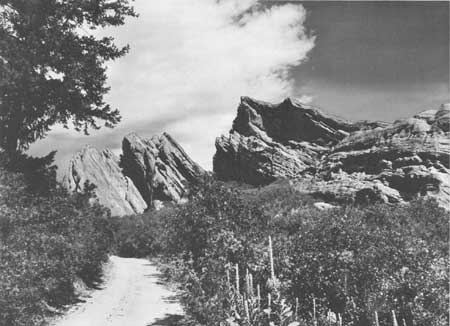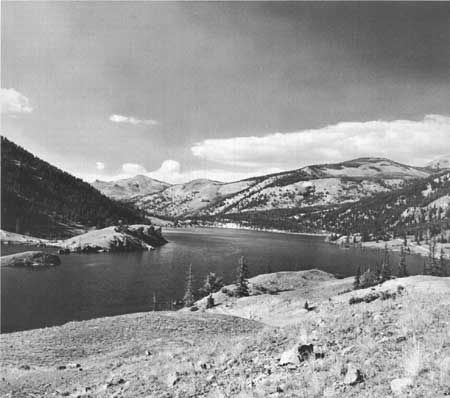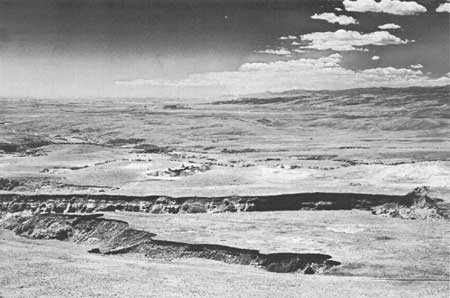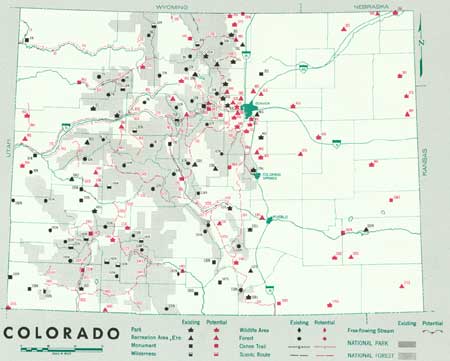.gif)
Parks for America
MENU
|
Parks for America
|

|

|
| The spectacular Roxborough Park area in Colorado is suitable for inclusion in the State park system. |
COLORADO
COLORADO, with numerous 14,000-foot peaks of the Rocky Mountains and a mean elevation of 6,800 feet, is a popular State for summer vacations and winter sports.
The State population increased 32 percent in the 1950-60 decade to 1,753,947, and projections indicate it will reach 2,580,000 by 1976. The Denver metropolitan area has 46 percent of the State population. The statewide density is 17 per square mile, with a wide range from less than 1 person per square mile in 3 counties to 7,483 persons per square mile in Denver County.
Tourist expenditures were an estimated $390 million in 1960. Tourism is facilitated by excellent rail and air service to the State from other parts of the country.
The Rocky Mountains are Colorado's prime outdoor recreation resource. Within its many scenic, forested mountain ranges are natural lakes, streams, scenic peaks and canyons, and other geological formations. Big game hunting is extensive in the mountains, and upland game and waterfowl plentiful on the eastern plains section.
There are many important historic and archeologic sites within the State, including fur trading post sites, ghost towns from the early mining era, and Indian cliff dwellings. Ten sites possess exceptional value in commemorating the history of the United States and are eligible for Registered National Historic Landmark status.

|
| Lake San Christobal, proposed as a State park for Colorado. |
EXISTING PUBLIC AREAS
NATIONAL: The National Park Service administers two national parks, six national monuments, one national recreation area, and one national historic site project. They total 526,412 acres and had an attendance of 2,951,000 in 1960. There are 12 national forests with a total of 13,710,311 acres administered by the Forest Service. Within the forests are 470 developed recreation sites on 6,200 acres and 11 wilderness areas containing 797,410 acres. The Bureau of Sport Fisheries and Wildlife manages one 12,401-acre national wildlife refuge. The Bureau of Land Management administers 8,245,000 acres of public domain land.
STATE: The State Park and Recreation Department manages 12,267 acres in 8 parks and recreation areas that had an attendance of 34,400 in 1960. The Department of Game and Fish has 78 areas that include 133,730 acres it owns or administers and 15,715 acres of water where land is administered by another agency. There is 1 State forest of 72,000 acres under the State Land Board. The State Historical Society has 6 historic sites, totaling 1,129 acres and having an attendance of 307,093 in 1960.
LOCAL: There are 49 major county and nonurban city parks amounting to a total of 38,557 acres.
PRIVATE ENTERPRISE: Numerous private lodges, winter sports facilities, boat marinas, cabins, resorts, and campgrounds are provided by private enterprise throughout the mountain regions of the State. Major resort centers include Estes Park, Aspen, Glenwood Springs, Colorado Springs, and Central City.
PARK AND RELATED NEEDS
Colorado possesses ample public lands available for outdoor recreation, but has the problem common to many Western States of needing park and recreation areas to serve its metropolitan centers and to provide a balanced system of parks, recreation areas, nature preserves, historic and archeological areas, scenic routes, and protection of free-flowing streams. The 38,017 acres in areas recommended or suggested for addition to the State park system and the 3,850 acres of potential local recreation lands should help meet these needs.

|
| At the Lindenmeier Site, on these high plains of Colorado, archeologists found a 10,000-year-old campsite of Folsom Man. The site is suggested as a possible national monument. (SMITHSONIAN INSTITUTION.) |
RECOMMENDATIONS
Existing recreation resources and many potential areas are shown on the accompanying tabulation and map, and the following recommendations are made to assist in providing needed outdoor recreation opportunities in Colorado.
NATIONAL: Further consideration of the Florissant Fossil Shale Beds, the Lindenmeier Archeologic Site, and the Durango-Silverton Narrow Gauge Railroad for national monument status.
STATE: Expansion of the State park system to protect valuable resources and provide recreation opportunities by the addition of 15 parks, 10 recreation areas, and 2 historic monuments, and further studies on 8 parks, 12 recreation areas, and 3 historic monuments. Designate and protect 27 scenic roads, 8 free-flowing streams, and 2 canoe trails with further study on 8 canoe trails.
LOCAL: Establishment of 4 major local park and recreation areas, and study of 4 more.
Supporting recommendations include—
1. Expansion of the State highway wayside program to give better distribution throughout the State in relation to major travel routes.
2. Provision for a highway marker system for historic and geologic sites.
3. Consideration of making fuller recreation use of water supply reservoirs.
4. Transfer of administration of recreation facilities in certain areas now administered by the State Department of Game and Fish to the State Park and Recreation Department.
5. Establishment of county park systems or recreation districts where needed, and development of out-of-city parks near the cities along the base of the front range.
6. Preserving through zoning, acquisition of development rights, or other means, the condition and atmosphere of one or more of the old mining towns such as Georgetown, Cripple Creek, Ouray, Silverton, or Telluride, and of an old Spanish village such as San Luis.
(Table omitted from online edition)

|
| (click on image for an enlargement in a new window) |
NEXT >>>
|
|
Last Modified: Mon, Sep 6 2004 10:00:00 pm PDT
parks_america/colorado.htm
 Top
Top